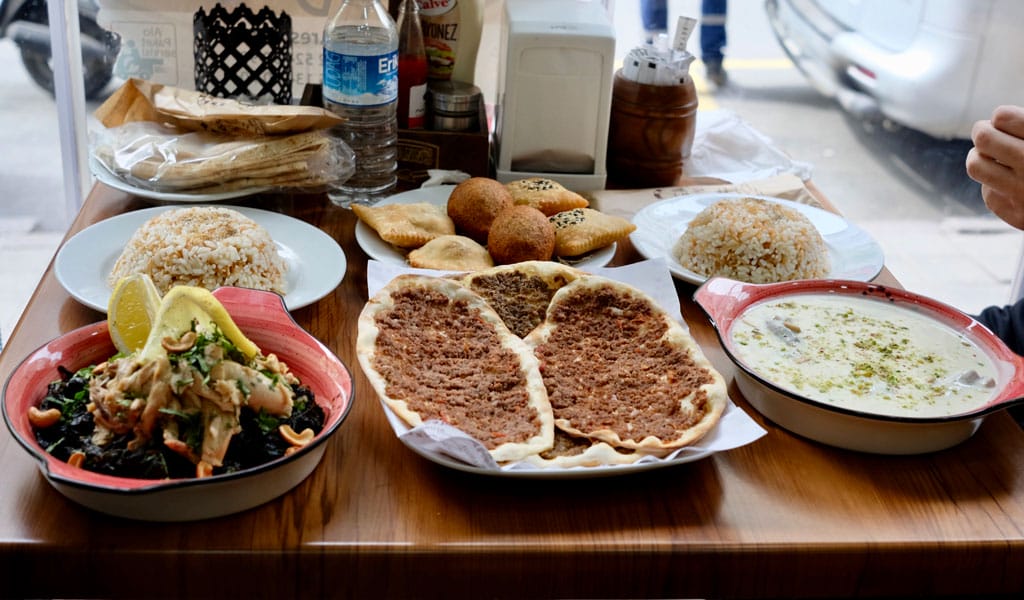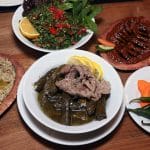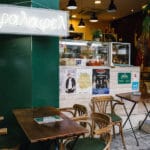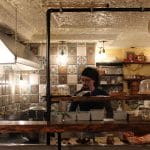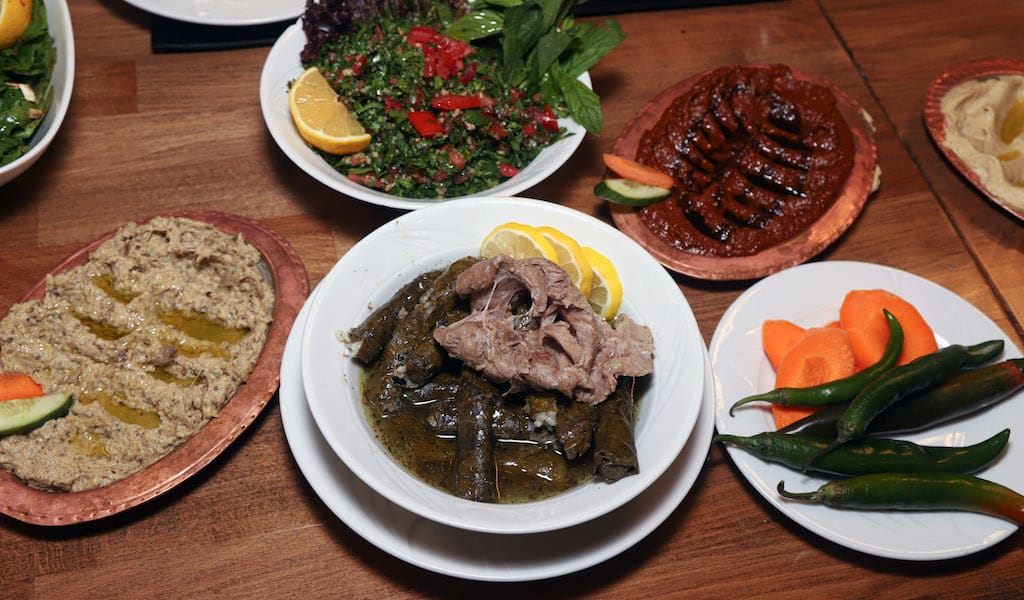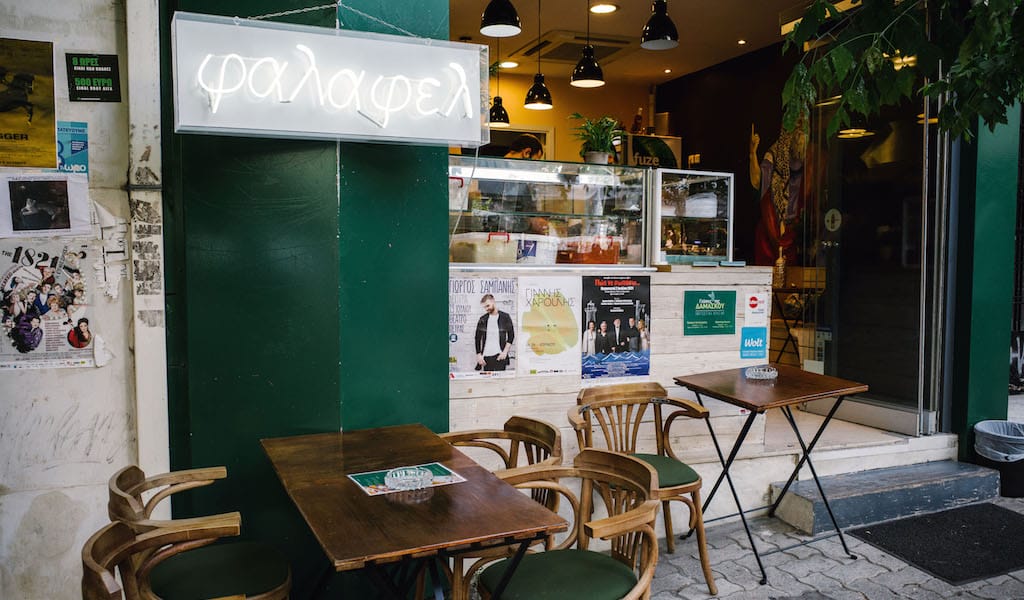Perhaps nowhere else is it clearer that as many as one million Syrians have settled down in Istanbul than in the city’s historic Fatih district. The neighborhood is home to the city’s immigration headquarters (Fatih Emniyet), and the backstreets leading up to it are among the most transformed, since Syrians and other new arrivals end up spending hours there, often taking multiple trips to the office to get their paperwork in order.
A stroll down the area’s Aksemsettin Caddesi reveals a dwindling number of Turkish markets and a rising number of Syrian ones, a collection of Syrian fast food joints, one Yemeni establishment and one eatery that transports its patrons through time and space, serving up dishes that in the past rarely made an appearance outside of the Syrian home kitchen.
“The first time I ate at Saruja I asked the waiter, ‘Do you have waraq enib?’” recalled my Syrian friend Muhammad Abunnassr, who is deeply loyal to the restaurant. The grape leaves stuffed with spiced ground beef and rice, slowly stewed for hours with garlic and lemon and beef broth are a labor-intensive classic, usually relegated to the home kitchen. “They said yes. I asked if they had sheikh il mihshi” – zucchini stuffed with spiced ground beef swimming in a warm, comforting yogurt sauce – “and they said yes.”
“I had been craving these foods for three years,” Muhammad said, counting the years since he left Syria. “When I tasted them, I remembered my childhood … the happy days [in Syria] when we used to have big meals at my grandma’s house,” he said with a pang of nostalgia.
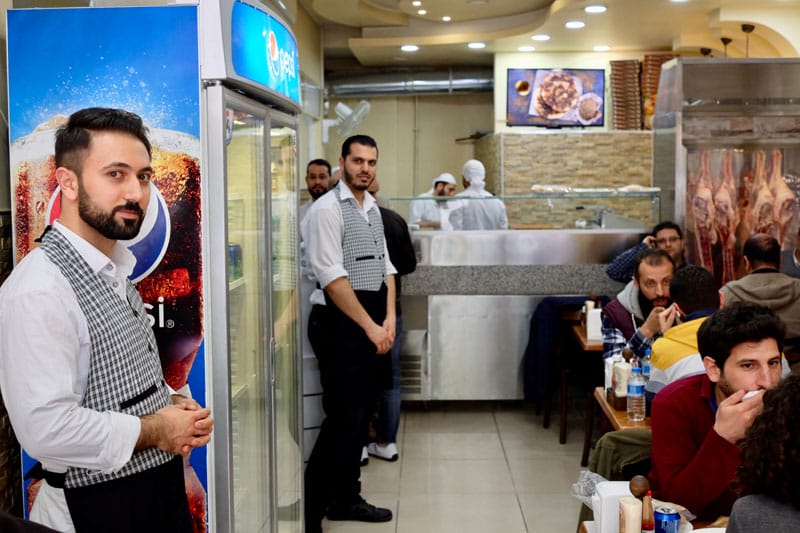
That’s not a coincidence. Saruja’s owner, Bilal Khalaf, ensured that the food tasted as close to his mom’s as possible. For a full month before Saruja opened its doors, Khalaf ran taste tests daily, inviting his brother and friends to give feedback. “My mom was here at the time and I’d bring her to try the food.” Khalaf’s mother had been visiting from their hometown of Damascus, where she still lives.
“One day she’d say there’s too much spice or too much cumin or too little salt,” he recalled, “and we kept going until it tasted just right.”
Syrian home cooking takes a lot of time, labor and love, and so Khalaf was very careful in selecting his head cook. “I interviewed a lot of chefs because I knew what I wanted to focus on in terms of Damascene food.”
Dishes with a base of hot yogurt are a mainstay at Saruja and the ultimate Damascene comfort food, as compared with the creative kebabs and kibbehs (oblong dumplings with a shell base of bulgur, often stuffed with ground meat but sometimes vegetarian) from Aleppo. Where the cuisines from Syria’s two largest cities collide beautifully is in a dish like kibbeh labaniyyeh – the dumplings made with spiced ground beef or lamb and pine nuts, served in a silky smooth yogurt sauce.
“When I tasted them, I remembered my childhood … the happy days [in Syria] when we used to have big meals at my grandma’s house,” he said with a pang of nostalgia.
“Thankfully, when we were younger my mom would have us help her in the kitchen,” he added. Rarely are dishes from the home kitchen served in Syrian restaurants, but as Syrians have become unstitched from their usual communities and flung far from their moms and grandmas and aunties, Khalaf knew there would be a demand for home cooking. He knew from personal experience.
Until 2013, Khalaf ran computer stores throughout Syria and in the United Arab Emirates, where he, his wife and his three daughters were living. But as Syria spiraled deeper into political and economic crisis, his shops were shut down, and eventually he had to sell the rest of what he had to survive. “I ended up sending my wife and kids to Istanbul because life in the UAE was too expensive,” he recalled with deep sadness. With no job and his family far away, he’d eat at a Syrian restaurant in Sharjah – an emirate in the UAE with a significant Syrian population – called Khobz wa milh, the Arabic version of “breaking bread.”
“The owner became a friend and knew me well … he knew I was jobless and very down, so he offered for me to manage the restaurant,” he explained. “To distract myself from how much I missed my wife and kids,” Khalaf recalled, pausing to swallow back tears at remembering that painful period, “I’d spend as many hours as possible at the restaurant, scrubbing the corners of the walls with my own hands.”
The eatery became successful under Khalaf’s management, and the owner offered to finance another restaurant. “I told him I wanted to open it in Istanbul.” And so, Saruja was born.
Khalaf put deep thought into every detail – even the eatery’s name. Saruja is the oldest part of Damascus outside the city’s ancient city walls and the first place the Ottoman Turks settled when the empire expanded into the Levant in the 16th century, he explained.
Beyond classic starters such as hummus, falafel and mutabbal (a smoky eggplant dip with tahini and garlic) found in Levantine restaurants across the globe, Saruja serves a few fixed dishes for lunch and dinner every day, plus a rotating menu of daily specials. Saturdays are for sheikh al mihshi, my friend Muhammad’s favorite, and the waraq enib are now served every day.

Any day of the week one can also order the kibbeh labaniyyeh, and while it tasted so close to the version I had growing up from my grandmother’s kitchen, there was a pinch of something special that took the dish from great to “foodgasmic,” as Muhammad calls it.
“Ah, there’s a secret ingredient,” our friendly waiter, Ayman, joked with a broad smile. “Our chef adds a small topping of garlic and cilantro.” He added that the flavorful garnish is unique to Damascus. The combination of sautéed garlic and cilantro is a mainstay of many Damascene dishes, but rarely is it incorporated into the hot yogurt sauce that defines Syrian comfort food.
And with that comfort food comes a comforting environment. The distinct masculinity that can define the usual Middle Eastern eatery is softened, embodying Khalaf’s own gentle, but dignified persona. The service is warm and welcoming, and the servers dish out their smiles as generously as they do Saruja’s delicious meals.
Khalaf says his goals are to represent all the good things Syrians have to offer to their new home city. Even more, he wants Saruja to serve as a dining room for the homesick.
Editor’s note: To celebrate our 2020 neighborhood guide, we will be republishing dispatches from the less-visited areas – like Fatih – that our correspondents are planning to explore this year. This article was originally published on April 28, 2017.
Published on January 15, 2020
Related stories
September 18, 2019
Istanbul | By Dima Al Sayed
IstanbulKhan al-Wazir is a remnant of Aleppo’s Ottoman past: In the late 17th century, the Ottoman governor of Aleppo commissioned the construction of this large caravanserai (in fact, its name means “caravanserai of the minister”), a building that housed both merchants and travelers. In 21st-century Istanbul, the former capital of the Ottoman Empire, a new Khan…
June 30, 2021
AthensFor Marina Liaki, Greece had long been a holiday destination, a place to visit family, soak in the sun and practice her Greek. So it was a shock when Marina, who is half-French, half-Greek and grew up in Paris, volunteered at a temporary refugee camp in the port of Piraeus in late 2015. The Syrian…
January 30, 2020
Istanbul | By Dima Al Sayed
IstanbulA commuter hub right on the Bosphorus, Beşiktaş courses with energy. In addition to the masses streaming on and off the ferries and the cars inching up and down the steep thoroughfare of Barbaros Boulevard, the neighborhood is overrun with students – Bahçeşehir University sits a few steps from the main ferry terminal. Of the…







































